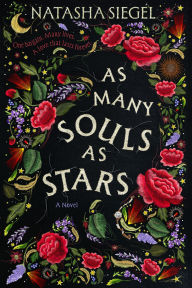Love & Hatred: A Guest Post by Natasha Siegel
A mortal witch and a powerful demon are cosmically intertwined through time and fate in this hypnotic story of longing, survival and the unexpected bonds we form. Read on for an exclusive essay from author Natasha Siegel on writing As Many Souls as Stars.
As Many Souls as Stars: A Novel
As Many Souls as Stars: A Novel
In Stock Online
Hardcover $30.00
An inventive and romantic speculative novel about two women—a witch and an immortal demon—who make a Faustian bargain and are drawn into a cat-and-mouse chase across multiple lifetimes.
An inventive and romantic speculative novel about two women—a witch and an immortal demon—who make a Faustian bargain and are drawn into a cat-and-mouse chase across multiple lifetimes.
While studying at university, I spent much time working on both Gothic literature and on Renaissance tragedy. I remember very clearly the first time I read Marlowe’s “Doctor Faustus”—the text that really ingrained the ‘devil’s bargain’ into the modern psyche. From the moment I finished it, I was utterly inspired. To me, the play is one that intimately intertwines experiences of otherness, of queerness, with violence: the violence we are willing to inflict upon ourselves, upon others, in our search for meaning. It’s that intersection that gives Marlowe’s writing a rawness and resonance that persists today and inspires constant reinterpretation and adaptation.
In As Many Souls As Stars I wanted to explore these ideas and consider how they might interact with queer womanhood, in particular; to bring a female perspective to a deal with the devil. At its core, the novel is a love story, but it’s as much about hatred as love. When passion becomes all-consuming, when it’s in contention what you and the world wants you to be—how can we reconcile ourselves with that? Across three time periods, my protagonist, Cybil, finds herself straining against the bonds of what society tells her, whether it’s as a witch, a debutante, or a femme fatale. In contrast my ‘demon’, Miriam, flaunts all expectations the world has of her: she responds with violence and fury, regardless of the consequences. For both these women the result of this struggle is isolation, until they find each other.
Writing a novel set across three time periods, with such epic scope, was a very new undertaking for me and came with its own set of challenges. The historical research required to imbue each section with its own detail was extensive, but it was incredibly rewarding, too. Part of the pure magic of historical fantasy as a genre is the ability to intertwine the real with the supernatural; to use the otherworldly to exaggerate the more ridiculous elements of our own world. Often while researching, I found that the reality of the past felt almost less believable than my demonic love interest did: whether it was a Tudor village performing a ritual at an anglo-saxon burial site, or a 1930s ocean liner with an entire Turkish Baths inside. These discoveries were part of the sheer delight of writing the book, and I hope reading it, too. But what mattered to me most of all were the characters, their endless push and pull of light and dark, the destruction and the salvation they each represent for each other. Cybil and Miriam change each other irrevocably. And isn’t that the true point of a love story, in the end?

